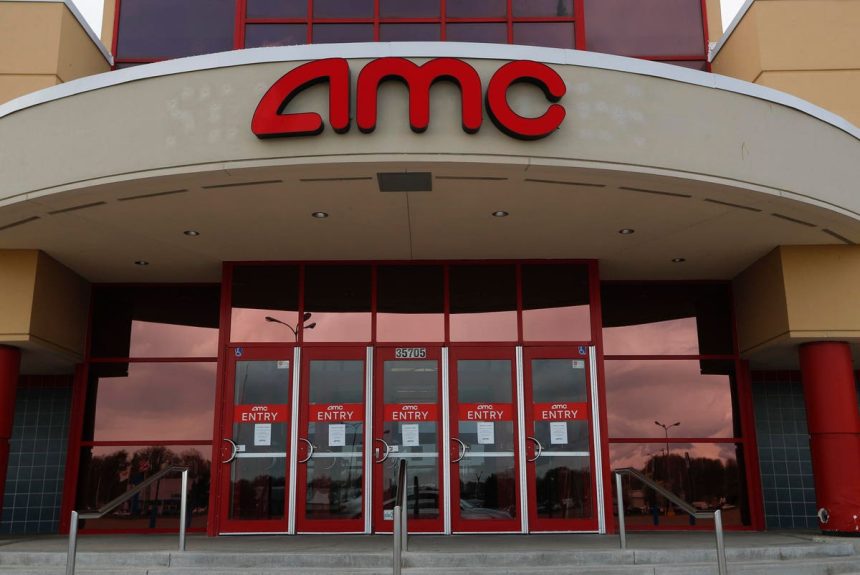AMC Entertainment (AMC) has dominated financial headlines for weeks and the good folks of Reddit aren’t to blame. The movie theater company is working through a complex plan to improve its balance sheet and reduce its interest expense burden.
Two key initiatives in the restructure are a reverse stock split and conversion of preferred equity into common stock. Read on to learn the details of these moves and whether they can keep AMC out of bankruptcy going forward.
What Is AMC’s 1-for-10 Reverse Stock Split?
AMC completed a 1-for-10 reverse stock split on August 24. The transaction doesn’t change the company’s value or the value of shareholder positions.
Stock splits and reverse stock splits redistribute a company’s value across a greater or fewer number of shares.
In a stock split, the share count rises and the share price falls. A 2-for-1 split, for example, doubles the share count and halves the share price. These effects cancel each other out, which is why the value of shareholders’ positions and the company’s market cap don’t change.
In a reverse stock split, the share count drops and the share price rises. A 1-for-10 reverse split like AMC’s should slash the share count to 10% and add a zero to the stock price.
Unfortunately for AMC, a tenfold rise in stock price hasn’t held. Why? Because, as you’ll see below, AMC investors have more to process than a reverse split.
What Is The APE Conversion?
The APE conversion is AMC’s move to convert its preferred equity shares into AMC common stock. APE stands for AMC Preferred Equity.
The reverse split and APE conversion are two parts of AMC’s plan to raise equity capital and reduce debt. The company has said these are necessary actions to avoid bankruptcy.
The Short, Controversial Life Of APE
AMC established APE shares in 2022. Typically, preferred equity has seniority over common equity with respect to dividends and in bankruptcy payouts. APE shares, however, did not have those perks. They had the same voting and economic rights as AMC common shares.
Importantly, APEs were also convertible to AMC shares on a 1-to-1 basis.
The creation of APEs laid the groundwork for AMC to access capital funding, without technically diluting its common shares. The company’s prior attempts to issue new common shares had not been well-received by investors.
Rather than battle with shareholders over a dilutive AMC stock issue, the company created the APE unit with authorization for 1 billion shares. In August 2022, AMC issued 517 million shares and distributed them for free to AMC shareholders. Each shareholder received one APE share for every one AMC share they owned. The move was intended to rally support from AMC’s meme investor base.
AMC subsequently raised $272 million by selling APE shares. That included $110 million from AMC’s creditor Antara Capital, LP. Antara also accepted 91 million APE units as payment for $100 million of AMC’s outstanding debt.
From an investor’s perspective, APE was not a successful stock. It began trading at $6.95 and eventually fell as low as $1.29.
However, APEs did fulfill their purpose for AMC. The movie theater company used APEs to raise cash and pay off or restructure debt. With those objectives played out, AMC decided to simplify its capital structure by converting APEs into AMC shares.
Mispriced stocks are hiding in plain sight and present great investment opportunities for the remainder of 2023. Forbes’ top investment experts share 7 overlooked stocks in this exclusive report, 7 Best Stocks To Buy Now. Click here to download it now.
Reverse Split And APE Conversion Controversy
AMC announced plans to reverse split its stock and convert the APE shares in December 2022. The company, needing shareholder approval for both initiatives, scheduled the shareholder vote for March 2023.
In February, a pension fund shareholder filed a class action lawsuit against AMC, claiming the company was staging an unfair voting process.
The issue? Both common and preferred shareholders would weigh in equally on the two initiatives, which were bundled into one vote. Since the preferred shares grossly outnumbered the common shares, the vote would go in the direction that favored preferred shareholders—and specifically, Antara Capital.
Here’s a timeline of what happened next:
- February: Delaware Judge Morgan T. Zurn authorized the shareholder vote but prohibited the conversion.
- March: As expected, shareholders approved the reverse stock split and preferred equity conversion.
- April: AMC and the plaintiffs agreed on settlement terms. Common shareholders would get one share of AMC for every 7.5 shares they owned.
- July: Judge Zurn rejected the settlement agreement, requesting removal of certain unenforceable sections that waived common shareholders’ rights.
- August: Judge Zurn approved the settlement agreement, clearing the way for the APE conversion. AMC stock fell dramatically after the announcement, diving into the $2 range in the days before the split.
With the lawsuit settled, AMC implemented the APE conversion on August 25, 2023. Consistent with AMC’s reverse split, each share of APE was converted into 0.1 shares of AMC.
How Were AMC And APE Investors Impacted?
With AMC’s reverse split and the APE conversion in the rearview mirror, here’s how things played out:
- The AMC reverse split happened on August 24. AMC shareholders who owned 100 shares before the split had 10 shares after the split.
- APE shares were converted into AMC shares on August 25. A shareholder owning 100 shares of APE effectively traded them in for 10 shares of AMC.
- The company issued nearly 7 million AMC shares for the settlement agreement noted above. Those shares were delivered to common shareholders at the end of August.
- Not counting the reverse split, the APE conversion would have raised AMC’s outstanding share count from about 520 million to more than 1.5 billion.
- After the split, conversion and settlement payment, AMC has about 158 million shares outstanding.
Although these moves were part of AMC’s plan to avoid bankruptcy, investors have not responded well. AMC was trading in the $2 range before the split and went to about $16 just after the split. The stock price then dipped below $11 after the APE conversion.
The main shareholder complaint is the dilutive effect of the conversion. The company essentially rolled what was formerly 1 billion shares of APE into the AMC share count. While the reverse split blurs the outcomes, higher share counts reduce EPS and lower the ownership percentage represented by each share.
Plus, there’s more dilution to come for AMC shareholders. On September 6, AMC announced its intention to sell 40 million more common shares. The company will again use the proceeds to repay debt and improve its cash position. AMC stock fell on the news and now trades below $8.
Mispriced stocks are hiding in plain sight and present great investment opportunities for the remainder of 2023. Forbes’ top investment experts share 7 overlooked stocks in this exclusive report, 7 Best Stocks To Buy Now. Click here to download it now.
What Do Analysts Say?
Analysts don’t agree on what happens next for AMC. The bulls argue that AMC’s capital restructuring moves have improved the company’s fundamentals and set the stage for growth. They also cite improving industry conditions, touting the summer box-office success of Barbie and Oppenheimer.
And then there’s Taylor Swift. AMC is screening Swift’s The Eras Tour documentary in theaters and capturing 43% of box-office revenues in the process. In the first day of ticket presales, the concert film sold $26 million—a record in advance ticket sales for AMC.
The bears have a different view. They characterize AMC as a value trap, arguing that there’s no fundamental improvement in the business. The company has struggled to generate profits for years, even before the pandemic shuttered movie theaters. The recent capital moves and the surprise $0.01 diluted EPS reported in the second quarter of 2023 may simply be too little, too late for AMC.
As for the industry, the summer movie season has been busy, but Hollywood writers and actors are on strike. The strike ensures a gap in content production, which will affect movie ticket sales in the months ahead.
What Is AMC’s Stock Forecast?
Eric World of B. Riley has an optimistic AMC price target of $45. That assumes AMC can return to pre-pandemic profitability. Riley thinks that’s possible because AMC can now raise capital to fund expansion or acquisitions.
Alicia Reese of Wedbush also sees upside, though not as much. She recently upgraded AMC from underperform to neutral and set a price target of $19.
Credit Suisse, Roth Mkm, and Citigroup analysts are less positive. On September 1, Credit Suisse lowered its price target on AMC to $8 from $8.38. Roth Mkm and Citigroup both recently reiterated their sell ratings on the company, and Citigroup dropped its price target to $1.55.
AMC’s Stock Split History
AMC’s reverse split in August was a first for the company. Prior to that transaction, AMC had not split its stock, either positively or negatively, since it listed on the NYSE in 2013.
At least, not officially. Unofficially, the distribution of APE shares in 2022 was effectively a 2-for-1 stock split. As noted, the company gave away one APE share for every one AMC share owned. While the two stocks had different tickers, they represented ownership in the same company. The stock dividend ultimately doubled AMC’s share count, just as a 2-for-1 stock split would.
Bottom Line
Early in 2023, analysts were predicting bankruptcy for AMC. For now, it looks like the movie theater company has delayed that outcome, thanks to some aggressive moves to stabilize its balance sheet. Investors aren’t sold on the strategy, however, and AMC stock has taken a beating.
Will AMC rise from debt-ridden meme stock to legitimate investment? The prevailing opinion is no.
If you want to invest in AMC, consider keeping your position conservative-at least until there’s more clarity on the long-term effect of the Hollywood strike and AMC’s growth strategy. Acquisitions or expansion efforts could change the company’s outlook significantly, for better or worse. Without more information, AMC remains a risky proposition.
Mispriced stocks are hiding in plain sight and present great investment opportunities for the remainder of 2023. Forbes’ top investment experts share 7 overlooked stocks in this exclusive report, 7 Best Stocks To Buy Now. Click here to download it now.
Read the full article here




